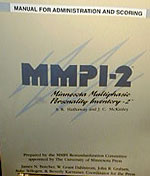|
2. Mental illnesses and disorders are more easily diagnosed, thanks to the
MMPI - Minnesota Multiphasic Personality Inventory

| The Minnesota Multiphasic Personality Inventory is the most widely-used clinical personality test. It was developed by two U of M researchers in the early 1940s, as a way to diagnose psychological disorders. It's now used in a wide variety of settings, including legal cases and hiring decisions for certain high-risk jobs.
(MPR Photo - Melanie Sommer)
|
The MMPI-2 (Minnesota Multiphasic Personality Inventory) is the most widely used objective clinical personality test. The MMPI-2 is used by clinicians in hospitals, clinics, counseling programs, and private practice to assist with the diagnosis of mental disorders and the selection of appropriate treatment methods.
Two University of Minnesota researchers developed the original MMPI in the early 1940s to diagnose specific psychological disorders, such as depression and schizophrenia. Starke Hathaway, a clinical psychologist, and Charnley McKinley, a neuropsychiatrist, read hundreds of short statements to mentally disturbed patients. They noted which statements the patients agreed with. The purpose of the test was to differentiate between people who did and did not have mental disorders, and between people with various types of mental disorders. Hathaway and McKinley learned that certain types of people tend to give certain responses on the test. The MMPI became a widely-used tool to diagnose problems by first determining who actually had them.
In July 1989 the MMPI was updated and restandardized, and published as the MMPI-2. Because the original MMPI was so widely used, great care was taken to improve the original while still keeping the revision compatible. The test was revised to eliminate sexist language, cultural bias, and objectionable questions about sex and religion.
The MMPI-2 consists of 567 statements to which the subject answers "true," "false," or "cannot say." It was designed primarily for adults, although a new version for adolescents was released in 1992. The items cover a wide range of topics, including attitudes on religion and sexual practices, perceptions of health, political ideas, information on family, education, and occupation, and displays of symptoms known to be exhibited by certain groups of mentally disturbed people.
The test provides scores on a variety of scales, which help diagnose serious mental illnesses such as depression and schizophrenia, as well as clinical problems such as anxiety, addiction, and post-traumatic stress disorder.
Because the MMPI-2 can also measure various aspects of personality, it has evolved into a tool for evaluating people in a wider variety of settings. It has become a controversial tool used by some employers to evaluate job applicants for certain high-risk occupations. The test is used frequently in the criminal justice system, to evaluate criminal defendants and victims, and in child custody cases. The MMPI-2 is also used in family counseling, career counseling, and substance abuse situations.
|